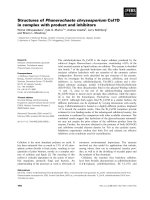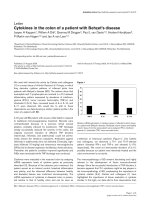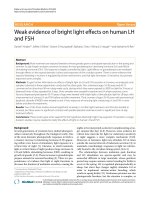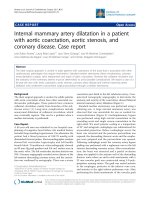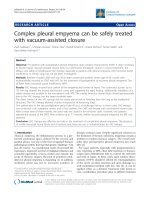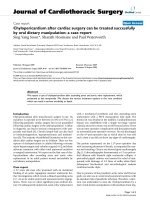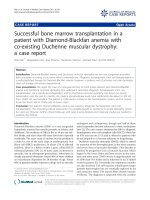Báo cáo y học: "Case report: Severe mercuric sulphate poisoning treated with 2,3-dimercaptopropane-1-sulphonate and haemodiafiltratio" ppt
Bạn đang xem bản rút gọn của tài liệu. Xem và tải ngay bản đầy đủ của tài liệu tại đây (75.49 KB, 6 trang )
Available online />Research
Case report: Severe mercuric sulphate poisoning treated with
2,3-dimercaptopropane-1-sulphonate and haemodiafiltration
Paul I Dargan
1
, Lucy J Giles
2
, Craig I Wallace
3
, Ivan M House
4
, Alison H Thomson
5
,
Richard J Beale
6
and Alison L Jones
7
1
Specialist Registrar in Medicine and Toxicology, National Poisons Information Service (London), Guy’s and St Thomas’ NHS Trust, London, UK
2
ICU Research Pharmacist, Intensive Care Unit, Guy’s and St Thomas’ NHS Trust, London, UK
3
Registrar in Emergency Medicine and Toxicology, National Poisons Information Service (London), Guy’s and St Thomas’ NHS Trust, London, UK
4
Trace Elements Analyst, National Poisons Information Service (London), Guy’s and St Thomas’ NHS Trust, London, UK
5
Senior Lecturer, Department of Medicine and Therapeutics, Western Infirmary, North Glasgow Hospital University NHS Trust, Glasgow, UK
6
Consultant Intensivist, Intensive Care Unit, Guy’s and St Thomas’ NHS Trust, London, UK
7
Consultant Physician and Clinical Toxicologist, National Poisons Information Service (London), Guy’s and St Thomas’ NHS Trust, London, UK
Correspondence: Paul Dargan,
R1
BAL = British anti-Lewsite (dimercaprol); CVVHDF = continuous veno-venous haemodiafiltration; DMPS = 2,3-dimercaptopropane-1-sulphonate;
ICU = intensive care unit.
Abstract
Introduction Inorganic mercury poisoning is uncommon, but when it occurs it can result in severe, life-
threatening features and acute renal failure. Previous reports on the use of extracorporeal procedures
such as haemodialysis and haemoperfusion have shown no significant removal of mercury. We report
here the successful use of the chelating agent 2,3-dimercaptopropane-1-sulphonate (DMPS), together
with continuous veno-venous haemodiafiltration (CVVHDF), in a patient with severe inorganic mercury
poisoning.
Case report A 40-year-old man presented with haematemesis after ingestion of 1 g mercuric sulphate
and rapidly deteriorated in the emergency department, requiring intubation and ventilation. His initial
blood mercury was 15 580 µg/l. At 4.5 hours after ingestion he was started on DMPS. He rapidly
developed acute renal failure and so he was started on CVVHDF for renal support and in an attempt to
improve mercury clearance; CVVHDF was continued for 14 days.
Methods Regular ultradialysate and pre- and post-filtrate blood samples were taken and in addition all
ultradialysate generated was collected to determine its mercury content.
Results The total amount of mercury in the ultrafiltrate was 127 mg (12.7% of the ingested dose). The
sieving coefficient ranged from 0.13 at 30-hours to 0.02 at 210-hours after ingestion. He developed no
neurological features and was discharged from hospital on day 50. Five months after discharge from
hospital he remained asymptomatic, with normal creatinine clearance.
Discussion We describe a patient with severe inorganic mercury poisoning in whom full recovery
occurred with the early use of the chelating agent DMPS and CVVHDF. There was removal of a
significant amount of mercury by CVVHDF.
Conclusion We feel that CVVHDF should be considered in patients with inorganic mercury poisoning,
particularly those who develop acute renal failure, together with meticulous supportive care and
adequate doses of chelation therapy with DMPS.
Keywords 2,3-dimercaptopropane-1-sulphonate, DMPS, haemodiafiltration, inorganic mercury, mercuric
sulphate, poisoning, toxicokinetics
Received: 29 October 2002
Revisions requested: 9 December 2002
Revisions received: 10 January 2003
Accepted: 22 January 2003
Published: 17 February 2003
Critical Care 2003, 7:R1-R6 (DOI 10.1186/cc1887)
This article is online at />© 2003 Dargan et al., licensee BioMed Central Ltd
(Print ISSN 1364-8535; Online ISSN 1466-609X). This is an Open
Access article: verbatim copying and redistribution of this article are
permitted in all media for any purpose, provided this notice is
preserved along with the article's original URL.
Open Access
R2
Critical Care June 2003 Vol 7 No 3 Dargan et al.
Introduction
Ingestion of inorganic mercury compounds can result in
severe toxicity, and blood mercury concentrations in excess
of 220 µg/l are associated with severe clinical effects [1].
Fatalities have been reported after ingestion of 0.5 g by an
adult, with a mean lethal adult dose of 1–4 g [1]. Inorganic
mercury causes toxicity by two mechanisms. First, mercuric
ions precipitate proteins that cause direct necrosis on
contact with tissues; this occurs in the mouth, stomach, large
bowel and kidney [2]. Mercuric ions accumulate in the
kidneys (accounting for 85–90% of the body burden) [1],
causing acute renal failure due to necrosis of the proximal
tubular epithelium, usually within 24 hours [2]. Second, inor-
ganic mercury complexes with a number of ligands, particu-
larly sulphydryl groups, causing inhibition of enzymes and
protein transport mechanisms [2]. This causes a metabolic
acidosis and, in the early phases of toxicity, it can cause
death due to metabolic acidosis, vasodilatation and shock.
Previously, dimercaprol (British anti-Lewsite [BAL]) was the
chelating agent of choice for inorganic mercury poisoning. It
is lipophilic and is given by intramuscular injection formulated
in peanut oil. It mobilizes tissue mercury by forming soluble
complexes, which are excreted in the urine [3]. In the anuric
patient these complexes accumulate, resulting in increased
toxicity of both BAL and mercury. The chelating agent of
choice for inorganic mercury poisoning is now 2,3-dimercapto-
propane-1-sulphonate (DMPS), which is much better toler-
ated and results in greater mercury excretion [4].
We describe here a case of severe poisoning due to mer-
curic sulphate, which was treated successfully with a combi-
nation of DMPS and high-flux continuous veno-venous
haemodiafiltration (CVVHDF) with no neurological or renal
sequelae. Data are also presented describing the toxicokinet-
ics of the mercuric salt and its clearance by CVVHDF.
Case report
A 40-year-old man ingested approximately 1000 mg mercuric
sulphate powder (obtained from his place of work) in a delib-
erate suicide attempt. He presented to the emergency
department of his local hospital 2 hours after ingestion com-
plaining of a ‘burning sensation’ in his throat. He had a
10-year history of depression and alcohol abuse, and had
taken an overdose of temazepam in the past. There was no
other medical history and he was on no regular medication.
His heart rate was 120 beats/min, his blood pressure was
130/80 mmHg and his respiratory rate was 30 breaths/min.
Initial blood tests, 3 hours after ingestion, revealed the follow-
ing (arterial blood gases taken on air): arterial oxygen tension
10.8 kPa, arterial carbon dioxide tension 5.0 kPa, pH 7.27
and base excess –9.0 mmol/l. His blood chemistry and
indices were as follows: plasma sodium 145 mmol/l, potas-
sium 6.2 mmol/l, urea 6.1 mmol/l, creatinine 166 µmol/l,
haemoglobin 14.3 g/dl, white cell count 10.0 × 10
9
/l and
platelet count 327 × 10
9
/l. His initial blood mercury concen-
tration was 15 580 µg/l.
Soon after presentation to the emergency department, he had a
large haematemesis and developed stridor and respiratory dis-
tress, requiring intubation and ventilation. His pharynx and
epiglottis were oedematous and haemorrhagic on laryngoscopy.
After telephone contact by physicians at the initial hospital
with the National Poisons Information Service, he started
treatment with DMPS. The first dose (250 mg) was given
approximately 4.5 hours after ingestion. He was transferred to
Guy’s Hospital intensive care unit (ICU) for management
under the joint care of the clinical toxicologists and ICU physi-
cians. He received DMPS at a dose of 250 mg intravenously
every 4 hours for the first 4 days. On day 4 he developed an
erythematous maculopapular rash with blistering over his
lower legs. Because this was felt to be due to DMPS [4], the
dose was cut to 250 mg every 8 hours and he developed no
further blistering. He remained on this dose until day 10,
when the DMPS regimen was changed to the oral form at a
dose of 200 mg/day for a further 9 days.
He was anuric by 12 hours after ingestion. In view of the
acute renal failure and the possibility of removal of mercury
and/or mercury–DMPS complex, he was commenced on
high-flux bicarbonate-buffered CVVHDF at 7 hours after
ingestion. CVVHDF was performed at a blood flow rate of
150 ml/min using a polyacrylonitrile hollow-fiber 0.9 cm
2
filter
(Hospal AN69-Multiflow100; Hospal Cobe, Rugby, UK). Fluid
replacement was administered postfilter using Haemosol-
XG0/LG4 (Hospal Cobe) together with a variable dose, con-
tinuous infusion of 8.4% sodium bicarbonate. To achieve
high-flux haemodiafiltration, these fluids were used as the
dialysis fluid infused counter-current at 2 l/hour in addition to
continuing haemofiltration at 2.5 l/hour. He remained anuric
until day 11 and oliguric (urine output <1 ml/kg per hour) from
days 12 to 43. He remained on CVVHDF until day 14 and
subsequently required eight sessions of haemodialysis for
renal support on days 16, 19, 22, 25, 29, 31, 34 and 37.
He had a further episode of haematemesis on day 9; upper
gastrointestinal endoscopy (oesophagogastroduodenoscopy)
showed confluent gastritis and two gastric ulcers with adher-
ent clot, which were injected with adrenaline (epinephrine).
He was transfused 15 U blood over the first 11 days (clotting
studies remained normal). He was commenced on intra-
venous pantoprazole (40 mg twice daily) and nasogastric
sucralfate (1 g three times daily) and had no further gastro-
intestinal bleeding.
He developed no focal neurological symptoms or signs at any
stage during his admission, in particular no tremor or fascicu-
lation. He remained cardiovascularly stable without the need
for circulatory support with inotropes or vasoconstrictors. He
was extubated on day 8 and discharged from the ICU to a
R3
general medical ward on day 14. He was reviewed by the
liaison psychiatry team on the ward.
When he was discharged from hospital on day 50, he was
asymptomatic, with a blood mercury of 32 µg/l and serum
creatinine of 185 µmol/l.
When reviewed in the medical outpatients department
5 months after discharge from hospital, he was asymptomatic
and psychologically stable. His blood mercury was 5 µg/l,
urine mercury 7 µg/l, serum creatinine 74 µmol/l and creati-
nine clearance 114 ml/min. He had a normal follow-up
oesophagogastroduodenoscopy performed 6 months after
discharge from hospital.
Methods of toxicokinetic modelling and
calculation of mercuric sulphate clearance
Every 6 hours, samples were taken of ultradialysate and from
the prefiltrate and postfiltrate arms of the extracorporeal circuit
(frequent sampling did not begin until 24 hours after inges-
tion). In addition, all ultradialysate generated was collected to
determine its mercury content; these samples and the blood
samples were analyzed using cold vapour atomic absorption
(Cetac M-6000; Cetac Technologies, Omaha, NE, USA).
Blood concentrations of mercuric sulphate were analyzed
using the nonlinear regression package WinNonlin (Pharsight
Corporation, Mountain View, CA, USA). Data were fitted
using a constant variance weighting scheme, and one-, two-
and three-compartment models were fitted to the data and
compared. These models had the general form:
Ct =
Σ
i
i=1
C
i
exp
–λ
i
t
Where Ct is the concentration at time t, C
i
and λ
i
represent
the parameters to be estimated, and i = 1, 2 and 3 for one-,
two- and three-compartment models, respectively. The
models were compared using the general linear test (signifi-
cance set at P < 0.05) and by examination of the standard
errors of the parameter estimates.
Filter clearance was determined using the excretion rate as
follows:
Filter clearance = UD
Hg
/(C
Hg
× ∆t)
Where UD
Hg
is the amount of mercury in the ultradialysate
and C
Hg
is the mean mercury concentration during the time
period (∆t) over which the ultradialysate bag was collected.
Sieving coefficients were calculated from the following:
Sieving coefficient = 2 × C
hfd
/(C
pre
+C
post
)
Where C
hfd
is the mercury concentration in the ultrafiltrate
(plus dialysate), and C
pre
and C
post
are the mercury concentra-
tions in the prefiltrate and postfiltrate arms of the extracorpo-
real circuit, respectively. Although sieving coefficients are
strictly only applicable under haemofiltration, they are included
here to illustrate mercury distribution across the membrane.
Results of the toxicokinetic modelling and
clearance data
Whole blood mercury fell rapidly during the first 30 hours
after ingestion, from 15 580 µg/l on admission (2.5 hours
after ingestion) to 3370 µg/l 27.5 hours later. Fig. 1 shows
the full concentration–time profile, including periods of
CVVHDF and doses of DMPS, and the fit obtained using a
three-compartment model. This model fitted the data best
when all of the data points were included (although the error
on the terminal rate constant was high, at 51%). When the
first data point was excluded, the two-compartment model
was satisfactory. Pharmacokinetic parameter estimates from
these models are presented in Table 1.
The total amount of mercury in the ultrafiltrate was 127 mg,
which represented 12.7% of the ingested dose of approxi-
mately 1000 mg. A total of 90% (114.2 mg) was removed
during the first 3 days of CVVHDF. The sieving coefficient
ranged from 0.13 at 30 hours to 0.02 at 210 hours after
ingestion. Filter clearance estimates fell from 10 ml/min at
Available online />Figure 1
Blood concentrations of mercury (µg/l) versus time. Also shown are
doses of 2,3-dimercaptopropane-1-sulphonate (DMPS) and timing of
continuous veno-venous haemodiafiltration (CVVHDF), including filter-
off periods. iv, intravenous.
1
10
100
1000
10000
100000
0 50 100 150 200 250 300 350 400 450 500 550 600 650 700
Hours post-presentation
Blood mercury concentration (µg/L)
Filter off periods
DMPS iv
250mg
4hrly
DMPS iv
250mg
8hrly
DMPS orally 200mg 12hrly
CVVHDF
R4
early time points to 1.6 ml/min 100 hours after ingestion
(Fig. 2).
Discussion
We present a case of potentially severe mercuric sulphate
poisoning in which the expected renal and neurological
sequelae were avoided. The initial blood mercury concentra-
tion is the highest recorded level in the literature that has
been associated with a favourable outcome. (There is one
report of a patient with a blood mercury of 22 000 µg/l who
died soon after presentation to hospital [5].)
When all of the blood concentration data were included in
the pharmacokinetic analysis, a three-compartment model
provided the best fit of the data, with estimates of half-lives of
6.6 and 57 hours for the initial and distribution phases, and
17.7 days for the terminal elimination phase. A potential
problem with the interpretation of these data is that DMPS
and CVVHDF were started between the first and second
blood mercury samples. The initial rapid decline may have
been due to an early distribution phase; however, an addi-
tional influence of DMPS cannot be excluded.
When the first data point was excluded from the analysis, the
best fit was obtained using a two-compartment model, with
the first phase having a half-life of 50 hours and the second
phase 15 days. Elimination of mercury appeared to decrease
after day 10, and there are a number of different explanations
for this. First, DMPS dosing was changed from 250 mg intra-
venously every 8 hours to 200 mg orally every 12 hours.
Critical Care June 2003 Vol 7 No 3 Dargan et al.
Table 1
Pharmacokinetic parameter estimates and precentage coefficients of variation obtained from the blood concentration–time data
Derived parameters (assuming an
Estimated parameters ingested dose of 1000 mg mercuric sulphate)
C
1
a
λ
1
a
C
2
a
λ
2
a
C
3
a
λ
3
a
Clearance Vss
b
λ
1
t½
c
λ
2
t½
c
λ
3
t½
d
Data set (µg/l) (/h) (µg/l) (/h) (µg/l) (/h) (l/h) x(l) (h) (h) (h)
All data Parameter estimate 15.2 0.105 3.18 0.0121 0.273 0.0016 1.74 381 6.60 57.2 425
% cve
e
25 28 14 15 47 51.3 9.14 37.5 28.5 15.3 51.2
Data minus Parameter estimate 3.66 0.0139 0.318 0.0019 2.33 572 50.0 362
first point
% cv
e
10.2 10.7 32.3 32.4 4.98 23.1 10.6 32.3
a
Concentration at t hours after dose (see Eqn 1 in text); C
1
, C
2
and C
3
are the coefficients associated with the i
th
exponent and λ
1,
λ
2
and λ
3
represent the distribution and elimination rate constants.
b
Vss is the volume of distribution at steady state.
c
Distribution half-lives.
d
Elimination half-
life.
e
Percentage coefficient of variation of the parameter estimate.
Figure 2
Mercury filter clearance estimates plotted against time.
0
2
4
6
8
10
12
0 50 100 150 200 250 300
Time post ingestion (hours)
Filter clearance (ml/min)
R5
Because the oral bioavailability of DMPS is 50% [6], this
dose change represented a two-thirds reduction in the DMPS
load. Second, CVVHDF was discontinued around this time
and renal support was continued with haemodialysis, which
would be expected to achieve a lower clearance of mercury
[7–12]. Another possibility is that this slow phase may reflect
a low rate of transfer of mercury between compartments, or a
change in the binding of mercury to protein fractions such as
metallothionein [13].
The usual elimination half-life of inorganic mercury ranges
from 30 to 100 days [2]. A case report of inorganic mercury
poisoning (with an initial blood mercury of 14 300 µg/l),
treated with DMPS and haemodialysis, reported bi-exponen-
tial elimination with half-lives of 2.5 and 8.1-days [14], which
are similar to those reported here. In two further cases of inor-
ganic mercury poisoning in patients with normal renal func-
tion, treatment with DMPS decreased elimination half-life
from 30 to 11 days [15]. This is consistent with our value for
the second phase, suggesting that CVVHDF had minimal
effects in enhancing elimination at this stage. However,
because sampling only continued until 26 days after inges-
tion, it is possible that we did not fully characterize the termi-
nal elimination phase.
During the early phase of CVVHDF filter clearance was esti-
mated to be 10 ml/min, which is higher than has previously
been reported. Overall, CVVHDF removed 12.7% of the
ingested dose. There have been previous reports of the use
of BAL with haemodialysis [7–12], dimercaptosuccinic acid
with haemodialysis [8], BAL with peritoneal dialysis [16,17],
DMPS with haemodialysis [14], BAL with haemoperfusion
[12,18], and BAL/DMPS with plasma exchange, haemodialy-
sis and haemofiltration [19]. Most of those reports showed no
significant removal of mercury by the extracorporeal device
[7–9,11,12,14,16]. The highest previously documented
clearances were 4.7 ml/min with the combination of BAL and
haemodialysis [10], 2.4 ml/min with the combination of BAL
and peritoneal dialysis [17], and 4.24 ml/min with the combi-
nation of BAL and plasma exchange [19]. However, in both of
the latter two reports, less than 1% of the ingested dose was
removed by peritoneal dialysis/plasma exchange, which
would not be expected to have a significant clinical impact.
The diafilter used in this patient allows passage of molecules
with molecular weights of up to 30 kDa, which greatly
exceeds the size of the mercury–DMPS complex (mercuric
sulphate 297 Da and DMPS 188 Da). However, protein
binding and distribution volume are more important determi-
nants of flux across the filter. Inorganic mercury is highly
(>99%) protein bound [18]. In addition, although the pharmaco-
kinetics of DMPS in the presence of inorganic mercury have
not been well described, it appears likely that the
DMPS–mercury complex would behave like the metabolized
form of DMPS, which has variable but high protein binding
and distribution [6]. Unfortunately, we were unable to assay
DMPS in the dialysate and so are unable to tell whether the
cleared mercury was free mercury or DMPS–mercuric
complex. The above kinetic data explain, in part, why mercury
elimination by CVVHDF (whether free mercury or DMPS–
mercuric complex) was limited to 12.7% and not higher.
Conclusion
We present a case of severe mercuric sulphate poisoning
with an initial blood concentration of 15 580 µg/l. The patient
was treated with DMPS and high-flux CVVHDF. Mercuric sul-
phate was eliminated by CVVHDF, contributing to the
removal of 12.7% of the ingested dose, mainly over the first
72 hours. We feel that this is clinically beneficial in patients
with severe inorganic mercury intoxication and that CVVHDF
should be considered in patients with inorganic mercury poi-
soning, particularly those who develop acute renal failure,
together with meticulous supportive care and adequate
doses of chelation therapy with DMPS.
Competing interests
None declared.
References
1. Gosselin RE, Smith RE, Hodge HC: Mercury. In Clinical Toxicol-
ogy of Commercial Products, 5th edn. Edited by Gosselin RE,
Smith RE, Hodge HC. Baltimore: Williams and Wilkins;
1984:262-275.
2. Winship KA: Toxicity of mercury and its inorganic salts. Adv
Drug React Ac Pois Rev 1985, 3:129-160.
3. Gabard B: The excretion and distribution of inorganic mercury
in the rat as influenced by several chelating agents. Arch
Toxicol 1976, 35:15-24.
4. Hruby K, Donner A: 2,3-dimercapto-1-propanesulphonate in
heavy metal poisoning. Med Toxicol 1987, 2:317-323.
5. Wineck CL: Fatal mercuric chloride poisoning. J Toxicol Clin
Toxicol 1981, 18:261-266.
6. Hurlbut KM, Maiorino RM, Mayersohn M, Dart RC, Bruce DC,
Aposhian HV: Determination and metabolism of dithiol chelat-
Available online />Key messages
• Inorganic mercury poisoning is uncommon but when it
does occur it can result in severe life-threatening
features and acute renal failure
• We present a case of ingestion of 1 g of mercuric
sulphate, with an initial blood mercury of 15580 µg/l,
the highest recorded level that has been associated
with survival
• Treatment with DMPS and CVVHDF resulted in
removal of 12.7% of the ingested dose by CVVHDF
• The patient developed acute renal failure but no
neurological features – at follow up 6 months later he
had no long-term sequelae
• DMPS is the chelating agent of choice and CVVHDF
should be considered in all patients with inorganic
mercury poisoning, particularly those who develop
acute renal failure
R6
ing agents. XVI: pharmacokinetics of 2,3-dimercapto-1-
propanesulphonate after intravenous administration to
human volunteers. J Pharmacol Exp Ther 1994, 268:662-668.
7. Worth DP, Davison AM, Lewins AM, Ledgerwood MJ, Taylor A:
Haemodialysis and charcoal haemoperfusion in acute inor-
ganic mercury poisoning. Postgrad Med J 1984, 60:636-638.
8. Kostyniak PJ, Greizerstein HB, Goldstein J, Lachaal M, Reddy P,
Clarkson TW, Walshe J, Cunningham E: Extracorporeal regional
complexing hemodialysis treatment of acute inorganic
mercury intoxication. Hum Exp Toxicol 1990, 9:137-141.
9. Samuels ER, Heick HMC, McLaine P, Farant JP: A case of inor-
ganic mercury poisoning. J Anal Toxicol 1982, 6:120-122.
10. Leumann EP, Brandernberger H: Hemodialysis in a patient with
acute mercuric cyanide intoxication. Concentrations of
mercury in blood, dialysate, urine, vomitus and faeces. J
Toxicol Clin Toxicol 1977, 11:301-308.
11. Newton JA, House IM, Volans GN, Goodwin FJ: Plasma mercury
during prolonged acute renal failure after mercuric chloride
ingestion. Hum Exp Toxicol 1983, 3:535-537.
12. Pelline TJ, Karjalainen K, Haapanen EJ: Haemoperfusion in
mercury poisoning. J Toxicol Clin Toxicol 1983, 20:187-189.
13. Nordberg M, Nordberg GM: Toxicological aspects of metallo-
thionein. Cell Mol Biol 2000, 46:451-463.
14. Toet AE, van Dijk A, Savelkoul TJF, Meulenbelt J: Mercury kinet-
ics in a case of severe mercuric chloride poisoning treated
with dimercapto-1-propanesulphonate (DMPS). Hum Exp
Toxicol 1994, 13:11-16.
15. Campbell JR, Clarkson TW, Omar MD: The therapeutic use of
2,3-dimercaptopropane-1-sulphonate in two cases of inor-
ganic mercury poisoning. JAMA 1986, 256:3127-3130.
16. Kahn A, Denis R, Blum D: Accidental ingestion of mercuric sul-
phate in a 4 year old child. Clin Pediatr 1977, 16:956-958.
17. Lowenthal DT, Chardo F, Reidenberg MM: Removal of mercury
by peritoneal dialysis. Arch Intern Med 1974, 134:139-141.
18. Keller F, Koeppel C, von Keyserling HJ, Schultze G: Haemoper-
fusion for organic mercury detoxication? Klin Wochenschr
1981, 59:865-866.
19. McLauchlan GA: Acute mercury poisoning. Anaesthesia 1991,
46:110-112.
Critical Care June 2003 Vol 7 No 3 Dargan et al.
